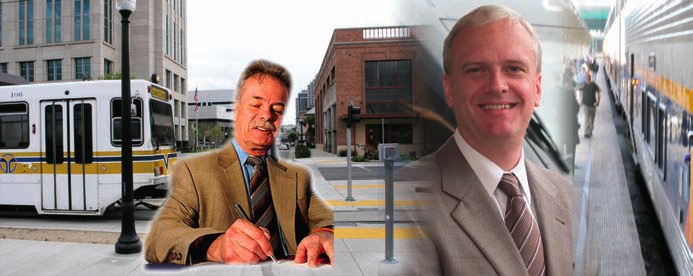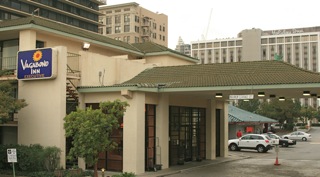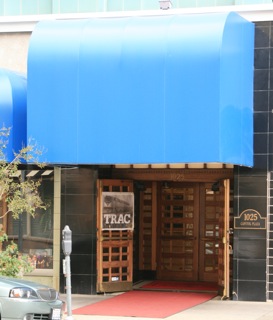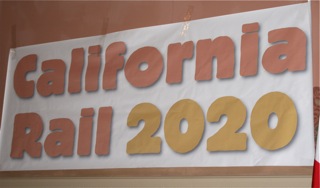Corridor Progress: ACE, Hubert J. Hanrahan; Amtrak San
Joaquins, William D. Bonte; California High Speed Rail, Bob Schaevitz
----------
Cal Rail 2020
ACE+Caltrain+Amtrak=Progress
----------
Hubert
Hanrahan
Manager, Customer Service & Marketing
San Joaquin Regional Rail Commission
Altamont Commuter Express (ACE)
929 East Channel Street
Stockton, CA 95202
1-800-411-RAIL
hubert@acerail.com
www.acerail.com
|
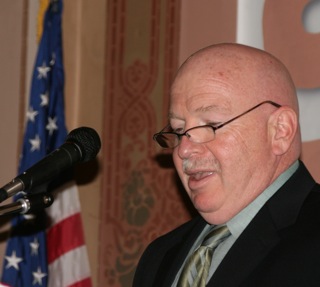
Hubert J. Hanrahan, ACE |
Mr. Hanrahan, through power point slides, and copies provided
attendees, mentioned that ACE recently celebrated 10 years of
service. They held a Rider Appreciation Celebration for their
10th Anniversary. They've added a 4th round trip. 754,229
riders to date which outdid all projections. They've had a 14%
increase in ridership. Measure K Sales Tax was used to form ACE
which opened October 19, 1998.
Currently at ACE, they have new locomotives this year making a
total of 6. Four new cars were added with luggage racks.
The cars have 8 less seats which is noticeable in the Quads.
Their 10-yr. scheduled overhauls are being conducted. A future
change will be to change the Stockton Station from a stub-in to
run-through station.

The Logo of the
High-Speed Rail Authority has undergone a change, which was on Bob's
handout cover. The word "FLY" has been added inside the
circle above, so it reads "Fly California." Also, a second line
has been added saying, "Without ever leaving the ground." I could
not find this new logo on their website to show you here.
Go to their modern website to see: FAQs, Routes, Gallery,
News & Facts, Library, and others:
http://www.cahighspeedrail.ca.gov/
|
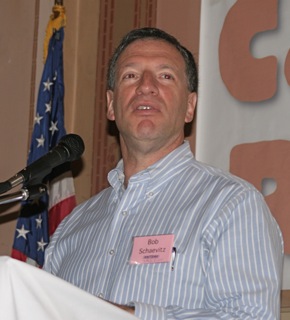
Bob Schaevitz, URS Corporation
|
Parts of his presentation:
Purpose
and need: 51 million people will live in California by
2030 (15% of the U.S. population). Three of five most congested
areas in the U.S. --Los Angeles (#1), --San Francisco-Oakland (#2),
--San Diego (#5). Auto congestion now costs $20 billion annually
and is growing 10% a year. LAX and SFO airports are among the
worst in on-time performance. California is the 12th largest
source of greenhouse gas emissions in the world. Emissions rose
by 15% between 1990 and 2004. 41% of the state's emissions come
from the transportation sector. Cleaner fuels and more efficient
vehicles along cannot achieve state AQ goals. The capacity of the
High Speed Train is equal to 3,000 miles of freeways ($66 Billion
cost), 5 airport runways and 90 departure gates ($16 Billion cost).
The
Solution - High Speed Rail. Total Length: 800
miles. 26 Stations. Service to over 90% of the state's
population centers. Priority (spine) segment and two
extensions.
"HST (High Speed Train) Priority
Segment: San Francisco to Anaheim via San Jose, San Joaquin
Valley, Antelope Valley (Palmdale), Los Angeles Union Station.
525 Miles. 16 Stations.
Maximum Sustained Operating
Speed: 220 mph (north of Bakersfield to Gilroy and
Stockton) Map at http://www.cahighspeedrail.ca.gov/map.htm
Project Details: State-of-the-art
electric steel-wheel-on-steel-rail technology. Double-track with
passing tracks at intermediate stations. Fully
grade-separated. "Open" specification compatible with European
and Asian Systems. Downtown stations connected to Amtrak,
airports, and transit. Ridership >100 million annually by
2030. No operating subsidy.
Segment Phasing. 5-7 Years:
SF to San Jose. LA to Anaheim. 7-10 Years: Merced to
Bakersfield. 10-13 Years: Bakersfield to LA. Merced
to San Jose.
High-Speed Train Benefits.
Economic Impact: Approximately $3 billion in annual
revenue. Approximately 160,000 construction jobs and 450,000
permanent jobs by 2035. Total economic impact over 45 billion
annually. Congestion Relief: Eliminate 70 million
auto trips annually. Reduce delays at California's 9 largest
airports. Energy Savings: Save 13 million barrels of oil
annually. GHG and Pollution Reduction: Reduced CO2 by 6.4
million tons per year by 2030, equivalent to 1.4 million fewer
passenger cars, Meet 50% of statewide greenhouse gas reduction goal for
land use and transportation. Support denser, transit-friendly
land use. Part of San Joaquin Valley APCD Clean Air Plan.
Cost and
Funding. Cost of Priority
Segment: $30 billion. Three-Part Funding Plan: State
Funds: $9 Billion (Pending bond issue). Federal
Funds: HSR legislation moving forward in both houses of
Congress. Private Investment: Revenue-backed investment via
Design-Build, DBOM, etc.
Timing of Funds. State/Federal commitments needed
for private participation. State funds all pre-construction and
early construction. Feds help fund initial segments (e.g., SF-San
Jose). Private funds invested after other funds committed.
Federal
Legislation. HR 2095 signed
into law (October 2008).
Private
Financing. California HSR
Authority has met with 70 private contractors, equipment vendors,
operators, and financiers. Discussed P3 approach to help fund the
HST Project. Received Expressions of Interest from over 50
possible partners.
Accelerated
Activity. Final Route
Approved. $46 million FY09 Budget Approved. Starting
Project-Level EIS/EIR Process. $9.95B Bond Issue on November
Ballot, $9B for HST, $950 Million for Other Rail Transit. [Which
passed, first Tuesday in November].
This report by
Bob Schaevitz, URS Corporation, was
the best prepared, delivered, and documented presentation this reporter
has heard at any TRAC Conference.
Q and A: There are 8 sections of the HSR, each with its own
Manager. Mr. Schaevitz is one Manager. It will be 15 years
projected to the opening. (That would be 2024.) Central
Valley Section will be the first built so it can demo. the 225 mph
maximum speed. In 7 yrs the first section will be opened, in 10
yrs the Anaheim Section will be one of two open.
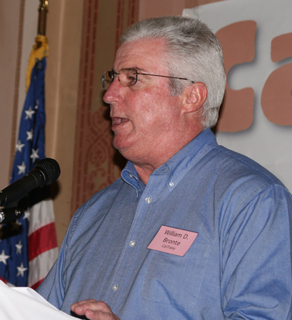
William D. Bonte, CalTrans
|
William
Bonte, CalTrans, began by saying he didn't like PowerPoint
Presentations because the presenter ends up watching the power point
rather than the audience. Therefore, there were no notes for the
audience or reporters, and any note taking of his speech should be
checked for accuracy with him.
Mr. Bonte started by saying that 2008 was a Great Year, with 11%
statewide ridership increase, 18% on San Joaquins and this was not
vacationers or kids on trains, 17% Capitol Corridor increase with 46.5%
farebox recovery, 7% Surfliner increase with 61% farebox
recovery. The overall farebox recovery goal is 51%.
The labor agreement at Amtrak means a 30% labor cost increase and
fuel cost has doubled.
Changes include midway cleaning of restrooms because of increased
ridership and more family friendly fares.
Biggest Issue is Budget. The aforementioned increased labor
anf fuel costs mean fare increases. From his $65 million budget
cut, there will be fewer capital improvements. CalTrans got $400
million from Propositions in 2006 that will be used for new
equipment. Prop. 1A provides $195 million. $47 million for
each of the 3 corridors. In the Reauthorization Bill, there is a
new part, "Capital Expenditures." This will provide $60 million a
year that is already matched. Senator Kerry has a High Speed Rail
Bill which has bonds for State Rail.
Q&A San Joaquins over Tehachapi? Not likely because it
is a congested UP and BNSF route so passenger trains through there
would be at the speed of the slowest freight.
After each speaker, Randall Hansen expertly collected, organized,
and read questions submitted by the attendees for the speakers.

Randall Hansen, Treasurer
|
 |
Richard Tolmach, TRAC Board Member from Sacramento county
introduced the next speaker, Will Kempton.
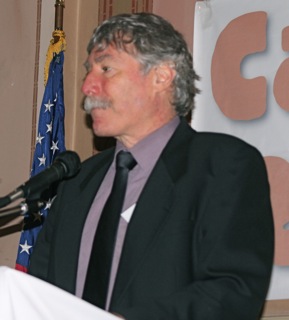
Richard Tolmach
|
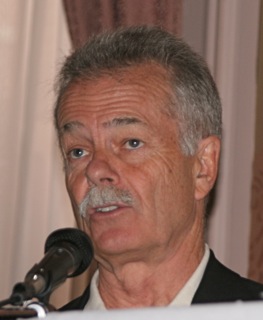
Will Kempton, CalTrans
|
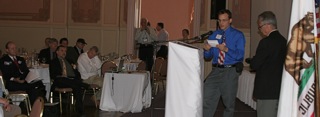
Guests could
submit written questions after each speaker. Randall handled the
Q & A with expertise.
|
Mr. Kempton rides trains to his Sacramento Office where he reads,
uses his phone and other work related activities, as do many state
government workers in Sacramento.
Ontime performance between Emeryville and Sacramento, where he
often rides the train for business, is great and beats an automobile on
the same trip. Mr. Kempton related that on several occasions he's
raced someone in a car while he rides the train on that same route and
he wins each time.
He mentioned that there are four sections of the National
Transportation Act: Highways, Freight, Transit, and Intercity
Passenger Rail. $38 billion is proposed.
Rail is still a small piece of our big problem of congestion in
California.
15% rail as share of total modal transportation is his goal.
Paris to Leoné, for instance, has 50% of the passenger traffic
going by rail.
There is a need to close the "Gaps" in our rail system. #1
San Fancisco to East Bay and Central Valley, #2 Bakersfield to Santa
Clarita, #3 San Jose to San Luis Obispo. Each Gap needs increased
speed and dedicated passenger track by public ownership with increased
frequency.
27 cars were acquired through California budget
negotiations. Los Angeles runthrough plan being implemented.
He is impressed with TRAC's rail advocacy and encouraged the
members present to keep up their advocacy.
Joseph McHugh, Amtrak VP, was introduced as the keynote speaker in
Mr. Kummant's absence.
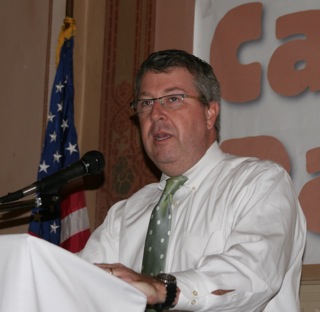
Joseph H. McHugh, Amtrak VP
|
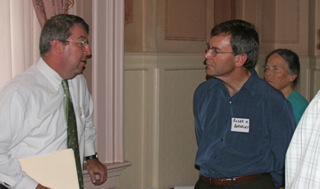
After Q & A, guests asked specific question.
|
He related that '07's ridership has gone from 25.8 million to 28.7
million in .08, an 11% increase. The Northeast Corridor (Acela) is down
some. It is estimated that 85% of the Acela riders are riding on
someone elses money such as business travelers.
He had an example slide of the Hiawatha Service as an excellent
service and mentioned that he could have used the Surfliner as his
example. The Hiawatha's slogan is "Milwaukee to Chicago, 90 miles
in 90 minutes." Their ridership
is up 25% after adding Mitchell Field.
His philosophy is the way to raise ridership is to add
corridors.
The Surfliner is the 2nd most travelled corridor in the US after
the N.E. Corridor. The New
York City to Washington, DC rail ridership in 2000 was 37% with the
rest air. Today it is 62% by rail. Boston to NYC was 20% in
2000, now 49% in 2008.
Next Challenges are: 1. There are 100 pieces of
equipment in Beach Grove, Indiana, Amtrak
Shops. i.e. 81 Amfleet cars are in Delaware and New
Orleans, with 12 - 15 to be redone next year. 2. Buy new
equipment - long distance cars, locomotives to be used in Albany,
NY, New diners and sleepers in the east, New cars in the
west, New trainset in the midwest, New high speed trainset for the
Acela Line.
In the reauthorization there are conditions on frieghts about
on-time performance of passenger trains.
The Chatsworth accident moved congress to act on reauthorization with
safety considerations.
There is talk of reinstating the Pioneer, the Sunset East,
Hiawatha, and others.
Positive Train Control (PTC) is due in 2015, but there must be
agreement on which system to use. It will cost $50,000 per
locomotive to equip it with PTC.
Political Implications: Trent Lott has been a big help in
getting the reauthorization. The Strongest support for Amtrak is
in the Senate. Barack will embrace Amtrak. Biden rides Amtrak to
work in Washington, DC, and his son is on the Amtrak Board.
Amtrak has been told to "Forget Strategy" and just "Implement the
Bill."
Mr. McHugh is the 3rd person in seniority serving as a VP at
Amtrak.
His philosophy is that you cannot let a labor contract run out to 18
months because they are strapped to deliver the back pay of the new
contract just signed. Congress likes Amtrak, but loves labor
unions.
Q&A: There is still an
unevenness of service among Amtrak employees across the US with "The
Best is in the West."
There is a 2% "quit rate" among Amtrak employees, the lowest in the
country of companies of this size.
He says to let Amtrak know about bad trip experiences. [ Editor:
One way to contact Amtrak is at: Amtrak Service Standards, 60
Massachusetts Ave NE, Washington, DC 20078-1828 ]
In reference to reestabishing the Pioneer and Sunset routes,
there is a 180 day report due on both. Sunset Ltd. east
difficulty is problem keeping it on time. It has 280 miles of
"dark railroad" and many stations were damaged by Katrina.
Reestablishing the Desert Wind, at least LA to Vegas is moving with an
Inspection Train running over the route two weeks before this
convention.
He had good comments about David Gunn, former Amtrak Chief.
Knowing now that Kummant is gone, maybe Gunn will be brought back.
Amtrak is trying to have all stations barrier free and
intermodal. 2010 is the deadline for ADA modifications.
They are trying to reduce debt from 4.2 billion to 1/2 billion to save
on debt service of $300 million a year.
Barack is the only presidential candidate that had Amtrak on his
website. Illinois has had rapid rail development and he's from
Illinois.
Mr. McHugh has his staff meet with mayors of towns along Amtrak routes
each year to help them make station improvements. There is grant
money available for stations for signage and station repairs.
Check the website:
GreatAmericanStations.com
San Francisco to Los Angeles route to
be reinstated requires new equipment and is not being considered now.
A
generous hot lunch buffet was provided onsite in the adjoining room at the Capitol Plaza Ballroom.
Vegetarian options were available.
